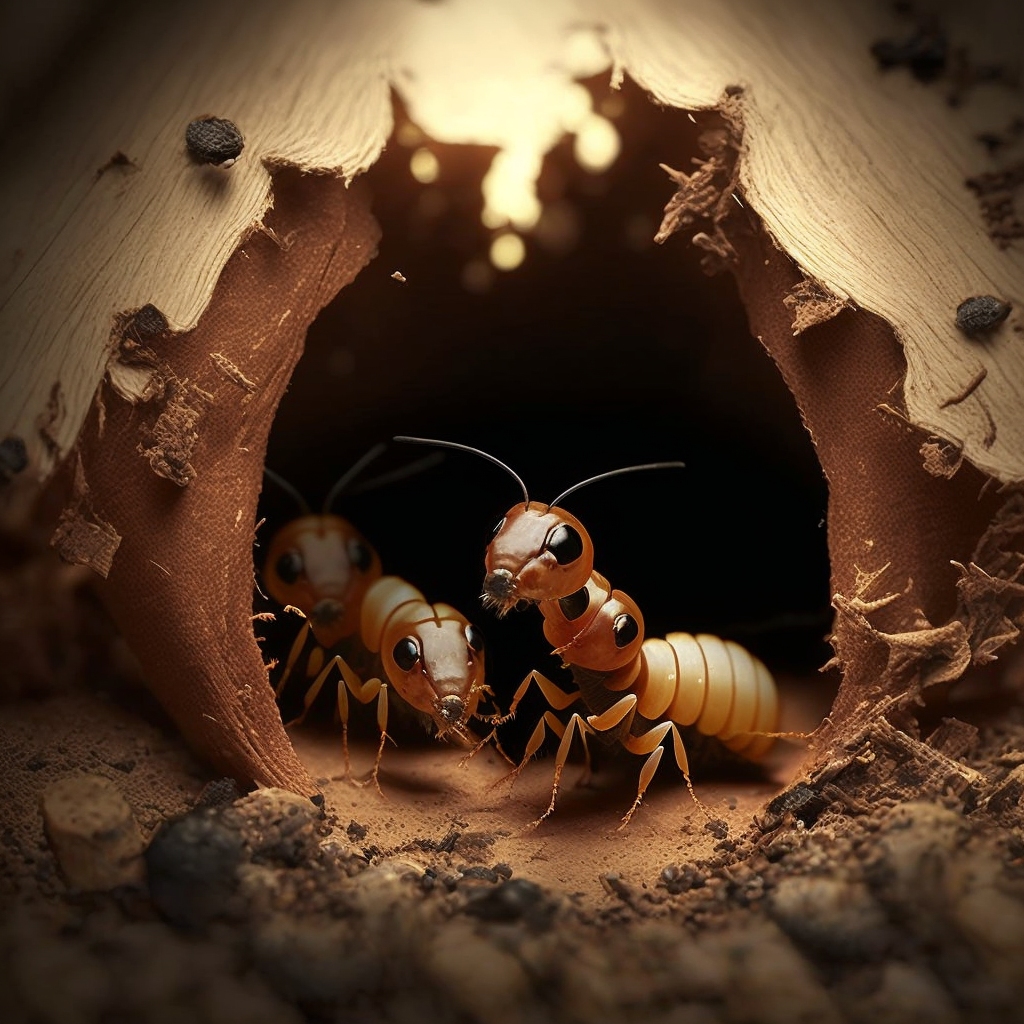What are Termite Eggs and what do they Look Like

Termite eggs are small, white and oval-shaped. They are typically less than 1/16th of an inch in length and have a sticky surface that helps them stick to surfaces.
The eggs are laid in clusters and can contain up to 200 eggs per cluster. These egg clusters are usually found in damp and warm places, such as soil or wood, which is why termite infestations often occur in moist environments.
The eggs typically hatch within three weeks and the larvae emerge from the shells as nymphs, which look like small wingless adults.
After they molt a few times they will eventually become adult termites with wings and start reproducing on their own.
Termite eggs may be difficult to spot because of their size, but if you suspect an infestation it is important to identify them as soon as possible in order to stop the spread of these pests.
If you look closely, termite eggs are usually white or cream in color with a smooth and glossy surface. They are also very small, measuring only about 0.2 inches in length and width.
If you see any sign of an infestation, it is important to contact a professional pest control service immediately as termites can cause significant damage if left untreated.
By identifying and eliminating the source of the infestation quickly, you can protect your home from further damage.
With proper treatment and regular inspections, you can keep your home safe from these destructive pests.
How Do Termites Reproduce
Termites reproduce asexually, meaning that only one parent is required to produce offspring.
The process of reproduction in termites begins with the establishment of a new colony by a single reproductive pair known as alates or swarmer.
These alates are winged males and females which fly away from their natal colony to find mates, establish new colonies and populate them with future generations.
The female and male alates will then mate inside the nest chamber where they form what is called a primary reproductives, or king and queen.
They will remain together for life and continue to produce eggs while other members of the colony take on specific roles such as soldiers, workers, or supplementary reproductives.
The eggs laid by the primary reproductives will then hatch and form the basis of a new colony.
The process of reproduction begins in the spring when swarmer termites emerge from their nest chambers, usually after a rainstorm.
The alates fly away to find mates and start establishing new colonies. After mating, they shed their wings and begin building nests in which they can lay eggs and populate with future generations.
Once established, the colony can expand rapidly as new workers take over duties such as foraging for food or caring for larvae.

Supplementary reproductives may also be produced to help produce more young termites and increase the size of the colony.
As it grows, reproductive pairs may break off and establish secondary colonies nearby that are connected by underground passages.
The reproductive cycle continues as long as the colony remains healthy and is able to produce enough young termites to survive and keep producing offspring.
When colonies become too large, some members of the nest may disperse to form new colonies elsewhere.
This helps sustain the population of termites in a given area, although it also exposes them to predation from other animals or environmental hazards such as droughts or floods.
In order for a colony to remain successful, its members must be able to reproduce quickly enough for their young ones to reach maturity before they die off. An average lifespan for a worker termite is only about three years, so without regular reproduction there is no guarantee that the colony will last beyond a few generations.
What Is the Life Cycle of a Termite

The life cycle of a termite is complex and consists of several stages. After hatching, young termites pass through a nymphal stage before molting into their adult form.
These nymphs molt several times while in the colony, and eventually emerge as either soldiers or workers.
Soldiers are tasked with protecting the colony, while workers are tasked with building the nest and gathering food for the entire colony.
Adult reproductive Termites leave the nest on mating flights to find mates and start new colonies. After fertilization, mated termites settle together to build a new home and begin producing offspring right away.
Termite eggs reach maturity in less than a month, at which point they hatch into larvae known as nymphs.
Nymphs can remain in this stage for up to six months before molting into adult termites with wings that enable them to fly out of the colony and start new colonies.
Once the winged adults leave, they shed their wings, mate, and build a new nest to begin the cycle again.
Throughout the life cycle of a termite, all stages depend on one another for survival of the colony. Without soldiers to protect them from predators or workers gathering food, a colony will not be able to thrive.
The reproductive stage is also essential in order for subsequent generations to continue its legacy.
With proper pest control measures in place, homeowners can ensure that these destructive pests don’t cause any damage to their properties.
By understanding the life cycle of a termite, proactive steps can be taken towards preventing infestations before they happen.
How can you Tell If you have a Termite Problem
The most common and obvious sign that you have a termite infestation is the presence of swarming termites in or near your home.
During certain times of the year, especially in spring, winged reproductive termites will emerge from their colonies to start new ones.
This swarm may occur inside or outside your house; if you see them it’s a sure sign of an active, established colony nearby.
If you spot them inside your home this could be indicative of significant structural damage already done by the pests.
Other signs include shelter tubes on exterior walls, mud tunnels in crawl spaces, buckling paint and plaster due to moisture buildup, hollow-sounding wood when tapped, discarded wings near windowsills or doorframes and excessive amounts of frass, a powdery substance that is the result of termite’s wood-eating activities.
It may also be possible to detect an infestation if you hear constant clicking or bubbling sounds coming from your walls or floors.
If you suspect a termite problem, it is important to contact a pest management professional immediately as they can identify and confirm the presence of the insect activity and provide treatment options to get rid of them. Professional exterminators will use specialized equipment such as thermal imaging cameras and moisture meters to accurately locate where and how bad the infestation is so that they can create a tailored plan for elimination.
What are the Dangers of Termites

Termites can cause extensive damage to buildings, homes, and other structures. They are relentless and will continue eating away at the structure until it is completely destroyed.
Their presence can also affect the air quality in a home or building, as they release a gas called methane during their digestion process.
This gas has been known to trigger asthma attacks and allergies in humans. As well as material damages, termites can also cause financial losses due to repair bills and replacement costs for damaged items.
If left unchecked, they can quickly become a major problem that is hard to get rid of without professional help.
To prevent termite infestations, it’s important to regularly inspect your property for warning signs like wood dust around windowsills or wooden doors that sound hollow when knocked on.
Additionally, make sure to seal any cracks or crevices in walls, floors, or foundation that can provide easy access for termites.
Finally, keep an eye out for swarms of flying termites around your property as they are one of the biggest indicators of a potential infestation. Taking preventive measures against termite invasion is essential in maintaining a healthy and safe living environment. Adopting these practices now can help you save time and money should an infestation ever occur.
How Do You Get Rid Of Termites
Termites can cause extensive and costly damage to your property if not dealt with quickly. To get rid of termites effectively, it is important to first identify the species of termite infesting your home, as different species require different control measures.
Once you have identified the type of termite, you can choose a control method or methods that will be most effective for getting rid of them.
There are three main approaches to getting rid of termites: chemical treatments, baiting systems, and physical removal.
Chemical treatments involve using an insecticide for direct application onto the affected areas. This approach works well for localized infestations and can provide good results when done correctly.

However, this approach requires a professional pest controller who can identify and treat the right areas.
It can also be hazardous, as it involves potentially toxic chemicals that can be harmful to humans, pets, and other animals.
Baiting systems involve using small boxes of bait filled with an insecticide or toxin that is attractive to termites.
These baits are placed around the perimeter of your home or in known infested areas. When they feed on the bait, it slowly kills them off without endangering humans or pets.
However, this approach requires patience as it may take some time for the bait to be effective.
Physical removal entails trapping and physically removing termites from your home by hand or mechanical means such as vacuums.
This approach is best used when there is a localized infestation and for spots that are hard to reach.
In addition to these approaches, there are also natural methods of getting rid of termites such as using beneficial nematodes or diatomaceous earth (DE).
Beneficial nematodes feed on termites and can be purchased online or in stores while DE is an all-natural powder made from the fossilized remains of microscopic organisms.
Both of these products are environmentally friendly and can be used as an effective way to get rid of termites without using toxic chemicals or pesticides.
No matter what approach you take, it is important to contact a professional exterminator if there is an extensive infestation or if you are unsure how to address the issue.
Professional exterminators have access to more advanced methods such as fumigation and spraying that may be necessary for getting rid of termites in your home. With their help, you can ensure that your home is free from these pests for good.




